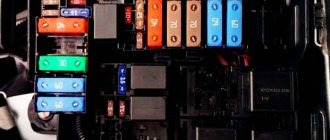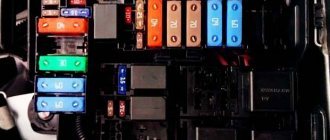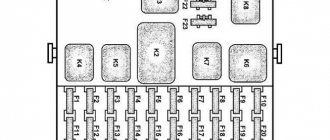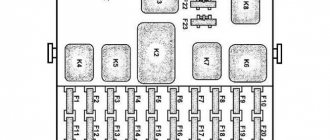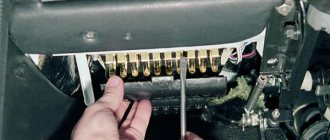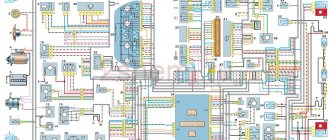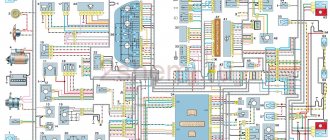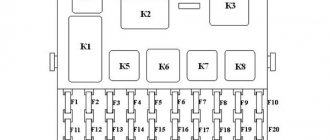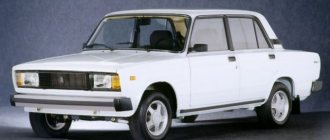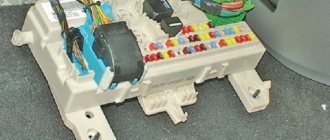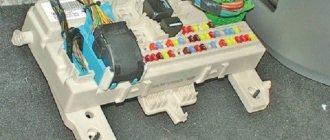February 27, 2015 Lada.Online 333 796 23
The relay and fuse box is also called the mounting block or black box. If problems are identified in the car related to electrical equipment, first check the fuses and relays. If they burn out, we replace them with the same ones, but first we must determine the cause of the burnout. The article contains a complete description of all Lada Largus mounting blocks.
Lada Largus fuse diagram
The first car of this VAZ family was released in 2011, and already in 2013 it became one of the leaders of the Russian car market, further consolidating its victory in 2014. Among the various options, the Largus Cross crossover is offered, which appeared in various trim levels in 2015 and 2021.
In 2017, it was announced the start of production of Lada Largus on gas, which was implemented in 2021, which also became the year of restyling of the family members. You can buy a car of the family with an 8-valve engine and a 16-valve engine. Unlike configurations, this does not greatly affect the set of fuses and relays that can be found in one of the two mounting blocks of the machine.
The first and main one is located in the cabin, and the second is under the hood, which is quite typical for AvtoVAZ models.
Video about additional cigarette lighter
Sometimes a second outlet is needed in the trunk or other location. For this you will need:
- drill with a bit of suitable diameter;
- files;
- wire cutters;
- cables, cross-section diameter 1.5 sq. mm;
- insulating tape;
- new cigarette lighter.
Procedure.
- We open the circuit.
- We find a level place.
- We cut a hole of a suitable diameter and clean the edges.
- We install the car cigarette lighter, connect it according to the pinout.
- We test the functionality and assemble the unit.
Below is a video on how to remove the cigarette lighter and install an additional socket on Largus and Kalina models, which will help you understand the situation.
Fuse box of Lada Largus in the cabin
The mounting block in the cabin is considered the main one, so the vast majority of electrical circuit fuses are installed here. To be more precise, this block is located to the left of the dashboard, at its end and is covered with a plastic cover, the fastenings of which are clearly visible.
| Fuse no. | Current (amps) | Which electrical circuit does it protect? |
| F1 | 20 | Windshield wiper, windshield wiper switch, heated tailgate relay |
| F2 | 5 | Instrument cluster, fuel pump relay, engine control unit (ECU) |
| F3 | 10 | Brake light switch |
| F4 | 10 | Diagnostic connector, immobilizer antenna unit, body electrical monitoring system |
| F5 | — | Reserve (R) |
| F6 | — | (R) |
| F7 | — | (R) |
| F8 | — | (R) |
| F9 | 10 | Instrument cluster, low left headlight |
| F10 | 10 | Low right headlight |
| F11 | 10 | Instrument cluster, high left headlight |
| F12 | 10 | Far right headlight |
| F13 | 30 | Rear door window motors |
| F14 | 30 | Front door power window motors |
| F15 | 10 | Electronic control of ABS system, acceleration sensors, steering angle sensor |
| F16 | 15 | Electrically heated front seats |
| F17 | 15 | Sound signal |
| F18 | 10 | Left front and rear side lights |
| F19 F20 | 10 7,5 | Right front and rear side lights, glove compartment lights, instrument cluster lights, hazard warning switch, HVAC controls, audio system, cigarette lighter, central locking switch, front power window switches, license plate lights, right rear side lights . Rear fog light |
| F21 | 5 | Electrically heated exterior mirrors |
| F22 | — | Reserve (R) |
| F23 | — | (R) |
| F24 | (R) | |
| F25 | — | (R) |
| F26 | 5 | SRS system |
| F27 | 20 | Rear door wiper motor, horn, TDC sensor, reverse light switch |
| F28 | 15 | Control of interior electrical equipment (energy saving mode) |
| F29 | 15 | Interior electrical control, diagnostic connector |
| F30 | 20 | Interior electrical equipment control |
| F31 | 15 | Fog lights and their relays |
| F32 | 30 | Heated tailgate glass |
| F33 | — | |
| F34 | — | |
| F35 | — | |
| F36 | 30 | Electric motor for heating, air conditioning and ventilation systems |
| F37 | 5 | Electric exterior mirrors |
| F38 | 15 | Audio system, cigarette lighter |
| F39 | 10 | HVAC Motor Relay |
Purpose of fuses in the block
The internal fuse block is equipped with elements responsible for the systems:
- 1 – windshield cleaning device, heated rear window;
- 2 – tidy, ECU control relay for fuel pump, navigation device;
- 3 – stop button;
- 4 – turn signals and power supply to the diagnostic block, control of the size relay, parking module;
- 5-8 – reserve cells;
- 9 – low beam of the left headlight, assistance in controlling the tidy, pump for the headlight cleaning system;
- 10 – is fully responsible for the low beam of the right headlight;
- 11 – far left side and tidy;
- 12 – far right;
- 13/14 – section of rear/front power windows;
- 15 – ABS device and steering wheel rotation and acceleration sensors;
- 16 – electric heating of the rear sofa;
- 17 – beep;
- 18 – side lights of the left side, illumination of license plates, glove compartment;
- 19 – dimensions on the right side of the car, illumination of license plates, glove box, emergency lights, acoustics, switches;
- 20 – rear fog lamp on the left side, and part of the dashboard;
- 21 – rear view mirror shades;
- 22 – navigation system terminal;
- 23 – empty;
- 24 – EUR;
- 25 – power supply to the gas installation;
- 26 – seat belt pretensioner device, airbag electronics;
- 27 – belt position indicator for driver, front passenger, rear window wiper, windshield washer pump control;
- 28 – acoustic module, instrument and interior lighting;
- 29 – diagnostic block, UCH;
- 30 – central locking;
- 31 – front fog lights;
- 32 – heated rear wind window and exterior mirrors;
- 33-35 – empty nests;
- 36 – stove and air conditioner;
- 37 – mirror control drive;
- 38 – cigarette lighter and speakers;
- 39 – depends on the configuration – is responsible for the stove, air conditioning, navigation system.
Largus fuse diagram under the hood
The mounting block in vehicles of the Largus family serves as the location for all relays and part of the fuses. Of the latter, those that protect the circuits of the motor control system are presented. The fuses are marked with the letter F.
The block is located to the left of the battery. To get to it, press out the latches holding the cover on the side, back and front.
| Relay/fuse no. | Current (amps) | Relay/fuse assignment |
| 231(A). | Fog light relay | |
| 753(B) | Headlight washer pump relay | |
| 233 | Heater Fan Relay | |
| F1/F2 | 60 | Electronic control of ABS and ESP systems |
| F1/F2 | 50/25 | Exterior light switch, interior fuse box |
| 700(A), | Cooling fan relay | |
| 474(B) | Air conditioning compressor relay | |
| F1 | 30 | Relay box power supply |
| F2 | 25 | Injection relay power supply |
| F3 | 5 | Power supply for injection system relay, ECU |
| F4 | 15 | Not used |
| 238(A) | Injection blocking relay | |
| 236(B) | Fuel pump relay |
Assignment of fuses in the engine compartment
Each structural element of the mounting block is responsible for its own circuit or separate device.
Purpose of fuse links:
- 43 – power supply for HBO electrics;
- 44/45 – control of ABS units;
- 46 – power supply to the ignition switch;
- 47 – signal to the cabin fuses located after the ignition switch;
- 51 – fuel pump, ECM, ECU relay, head fan, ignition coil protection (depending on modification), phase distribution, canister and DC 1 purge;
- 52 – air conditioning system clutch, radiator head cooler.
Separately, you should consider the protective relays located in the block:
- 299/1 – fog lights and headlight washer;
- 299/2 – turning on the stove;
- 597/1 – control of ABS and ESP systems;
- 597/3 – external optics switch drive, power supply to the interior fuse box;
- 784 – control of activation of the radiator fan and air conditioner.
Fuse box in the engine compartment (VAZ 11189 (8 cells), 21129 (16 cells))
The second part of the electronic safety system is located under the hood. In the figure, the mounting block is indicated by the letter “B” and is hidden under a plastic cover. To open the panel, snap off the plastic clips or unscrew 4 screws (depending on the modification).
For the 8 and 16 valve versions, the placement of the platform is the same.
Talk and show: how not to burn your car
What can and cannot be plugged into a car cigarette lighter socket? On-board 12 V sockets, a burnt-out Honda and precautions - this and not only in our educational material.
Several years ago, an intriguing story appeared on many TV channels: a lady’s Honda Civic burned down. They say, I started charging my mobile phone, and then there was smoke, a stench and a full guard... In general, an unpleasant story. But who is to blame?
The television people who rushed in for an interview were openly offended by us: our opinion disappointed them, and the expected scandalous sensation did not happen. Because, in our opinion, no Honda is obliged to be responsible for the behavior of a device unknown to it. Humanly speaking, of course, one can sympathize with the lady, but the obvious culprit of the fire was a charger of unknown origin. And car manufacturers, as a rule, prohibit plugging everything into a socket - and rightly so. Those who disagree with this can mentally put themselves in their place: would you allow it? That's it - it's better not to...
In that story, the court sided with the car dealer’s representatives and rejected the claim. The reason was “violation of vehicle operating rules.” Arguments like “Everyone does this” don’t count: you have to answer for yourself personally.
Do's and Don'ts
What can you plug into a car socket anyway? Unfortunately, there is no clear distinction between what can be done and what cannot be done. We conducted research on this topic, but the results were not clear. Some car manufacturers only allow the use of devices with their own brand on the label, others nod to mandatory compliance with the requirements of a certain SAE standard (and which car owner has seen it?), others categorically prohibit the use of the cigarette lighter socket for any unauthorized consumers, others stipulate the maximum current consumption...
It is necessary to distinguish the cigarette lighter socket from the on-board socket. Historically, the cigarette lighter appeared earlier - almost a hundred years ago. On the same Zhiguli, for example, there were no sockets - however, there were no gadgets for sale in those days either. Today we are actively fighting smoking, and therefore cigarette lighters are becoming a thing of history. But there are several sockets in a car. At the same time, a lot of problems are caused by discrepancies in the designs and sizes of both the sockets themselves and the plugs. In particular, in a regular socket there is no bimetallic spring-grip for the cigarette lighter. In practice, many plugs like to jump out of their socket or, worse, make bad contact. Manufacturers of gadgets use different plugs - it was this circumstance that, in our opinion, was the cause of the car fire mentioned above.
Why didn't the fuse blow on that car? By the way, usually its nominal value is 15 A, less often - 10 A (in Zhiguli they used 16 A). Now imagine what happens if for some reason the device consumes a similar current for a long time, and the contact “sparks”. Solid power begins to dissipate in the outlet, which quickly heats up and... well, the rest becomes clear. If there is thermoplastic around that is afraid of heating, then exactly what happened to the lady will happen. The fire was not a fire, but the torpedo melted. In this case, the current can remain within the tolerance limits - this is not a short circuit! On my own behalf, I’ll add that in practice, fuses can often easily withstand increased current: this is not good, but - that is what it is...
